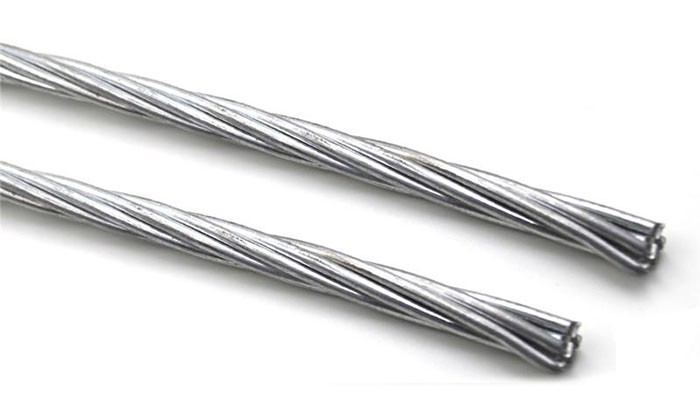Guy wires are essential components in various industries, providing stability and support to structures that would otherwise be vulnerable to the elements. While the term “guide wire electrical” is sometimes mistakenly used, it’s crucial to understand the correct terminology and application of guy wires in electrical and other contexts. This guide will delve into the true nature of guy wires, their uses, and the factors to consider when selecting and installing them.
Defining the Guy Wire
A galvanized guy wire used for structural support.
A guy wire, also known as a stay wire or guy strand, is a tensioned cable designed to provide support and stability to structures, particularly those that are tall and slender. They are commonly used to brace utility poles, communication towers, antennas, wind turbines, and other structures against the forces of wind, ice, and other environmental factors. These wires transfer the weight and stress of the structure to the ground, ensuring it remains upright and stable.
Why “Guy Wire,” Not “Guide Wire”?
The term “guy wire” originates from the Dutch word “gei,” referring to a rope used to secure a sail to a mast. While “guide wire” might seem like a logical alternative, it’s technically incorrect in this context. The primary function of these wires is to “guy” or secure the structure, not to guide it.
How Guy Wires Provide Support
Guy wires are strategically attached to a high point on the structure and anchored to the ground, creating a diagonal line that resists lateral forces. The anchor, often a concrete-embedded rod, provides a secure point of attachment for the wire. This configuration effectively transfers a portion of the structure’s weight and the stress from external forces to the ground, preventing it from leaning or falling.
Applications of Guy Wires
Guy wires find widespread use in various industries and applications:
- Power Systems: Utility poles and transmission towers rely on guy wires to withstand the tension of overhead power lines and environmental loads.
- Telecommunications and Broadcasting: Antenna masts and communication towers use guy wires to maintain stability and ensure reliable signal transmission.
Essential Guy Wire Fittings
Guy wires are used in conjunction with a variety of fittings to ensure secure and effective support. Some common fittings include:
- Dead End Grips: Used to terminate the guy wire at the anchor point, providing a secure and reliable connection.
Application of a dead end grip to secure a guy wire.
- Guy Grips: Designed to grip the guy wire tightly without causing damage, providing a strong and durable connection.
- Guy Clamps: Used to secure the guy wire to the anchor rod, preventing slippage and maintaining tension.
- Guy Thimbles: Inserted into the loop of the guy wire to protect it from abrasion and wear at the connection point.
- Pole Bands: Used to attach the guy wire to the utility pole or tower, providing a secure and stable connection.
- Pole Top Make Off: A clamp used on top of the power pole to secure it to the ground.
- Shackles: Used to connect wire ropes, chains, and slings.
- Stay Insulators (Egg Insulators): Provides insulation in the guy wire to prevent electrical shock.
- Stay Rods: Supports the joined parts and is utilized with guy wires in tower construction and electricity poles.
- Turnbuckles: Used to adjust the tension in the guy wire.
Factors Influencing the Need for Guy Wires
Several factors determine whether guy wires are necessary for a particular structure:
- Height: Taller structures are more susceptible to wind and other lateral forces, increasing the need for guy wires. Structures exceeding 20 feet typically require guy wire support.
- Terrain: Structures located in areas with steep terrain or frequent severe weather are more vulnerable and may require guy wires even at lower heights (e.g., 10 feet).
Proper Guy Wire Installation
While the installation process may seem straightforward, it’s crucial to entrust it to experienced professionals. Proper installation ensures the effectiveness and longevity of the guy wire system.
The installation process generally involves:
- Attaching one end of the guy wire to the structure’s upper section using appropriate fittings.
- Securing the other end to a ground anchor.
- Adjusting the tension of the wire to achieve optimal support.
- Ensuring that multiple wires are evenly spaced (typically 120 degrees apart for three wires and 90 degrees for four).
Ongoing Inspections and Tests
Regular inspections are crucial for maintaining the integrity and safety of guy wire systems. Inspections should include:
- Visual checks: Look for signs of broken wires, corrosion, distortion, or damaged components.
- Tension testing: Verify that the wires maintain the appropriate tension levels.
- Component assessment: Examine clamps, thimbles, and anchors for wear or damage.
Selecting Quality Guy Wires
When choosing guy wires, consider the following factors:
- Material: Galvanized steel is the most common material due to its strength, durability, and resistance to corrosion.
- Stranding: Guy wires are typically constructed with multiple strands of wire for added strength and flexibility. Common configurations include 7-wire and 19-wire strands.
- Strength: Select a guy wire with a breaking strength that exceeds the anticipated loads and stresses.
- Coating: Ensure that the zinc coating is uniform and free of imperfections to provide adequate corrosion protection.
Choosing a Reliable Manufacturer
Selecting a reputable manufacturer is essential for ensuring the quality and reliability of guy wires. Look for manufacturers with:
- Proper licensing and certifications.
- Adequate production capacity to meet your needs.
- Positive reviews and a track record of quality.
- Compliance with regional quality standards.
Conclusion
Guy wires are indispensable for maintaining the stability of structures in various industries. Understanding the correct terminology, proper applications, and factors to consider when selecting and installing guy wires is crucial for ensuring safety and reliability. While the term “guide wire electrical” is technically incorrect, the principles of guy wire application remain the same. By following best practices and working with reputable manufacturers, you can ensure that your structures are well-supported and protected against the elements.


